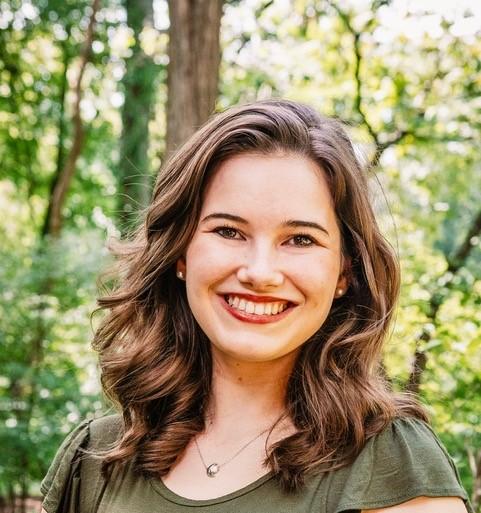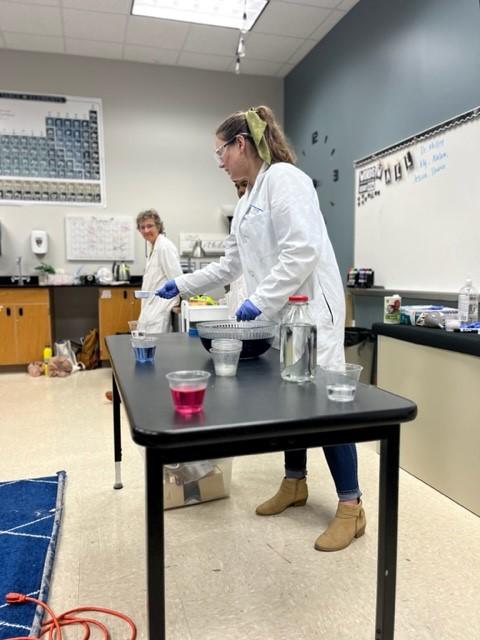By Richard LeComte

LEXINGTON, Ky. -- Alyson Ackerman’s success as a doctoral candidate in chemistry at the University of Kentucky is attributable directly to St. Nick.
“I don't know exactly what got me interested into chemistry, but I do know that I've always been into it,” said Ackerman, who grew up in Lexington, earned her bachelor’s degree in chemistry from UK in 2018 and now is a National Science Foundation graduate research fellow. “I did get a microscope for Christmas when I was 11. That was my big Santa gift. I played with my microscope a lot growing up to identify contents of the nearby creek.”
As an undergrad in UK’s College of Arts and Sciences, Ackerman was a Patterson Scholar and earned department honors in chemistry as well as the Nancy J. Stafford Award. After spending four years as a quality control chemist at Murty Pharmaceuticals, Ackerman returned to the UK labs in 2022.
She’s getting help from the National Science Foundation’s Graduate Research Fellowship Program. The program offers elite students a $37,000-a-year stipend for three years; Ackerman applied in her second year of graduate study, so the stipend will cover the rest of her studies. The fellowship requires applicants to submit a proposal for a project — any project in the sciences — and explain it to a hypothetical funder.
"It's specifically meant for graduate students who they think will have a career in academia,” she said. “They basically want to see that you have the ability to conceptualize a project from start to finish and that you can explain it to people who have a similar background but aren't experts in the field. So I had to write a research proposal, but it didn't have to be on anything I was actually doing. I just had to show I could convey the idea and reasoning for wanting to pursue the research. My proposal is adjacent to my main work, so while it isn’t the current focus, I do plan on tying it into my dissertation eventually.”

Ackerman, whose specialty is medicinal chemistry, is preparing for her oral qualifying exam in the fall and working on a project that will be a big element of her dissertation. Her lab is on the third floor of UK’s Chemistry-Physics Building.
“I started off in analytical chemistry, which I learned to love in the pharmaceutical industry. I was working on identifying substances, isolating them, purifying them," she said. “I have a joint advisership with UK chemistry professors Dr. Bert Lynn and Dr. Samuel Awuah, who had an existing collaboration involving natural products for cancer treatment.
“I dabbled in cancer research as a high school researcher with Dr. Plattner here at UK and fell in love with cell work. It’s been a dream to combine these research passions,” she said. ”
The research she is leading involves synthesizing a chemical found in a plant used in traditional Chinese medicine and investigating how it can battle cancer cells without affecting healthy ones.
"Dr. Lynn read a publication from 2020 in which scientists in China had taken a plant used in traditional Chinese medicine,” she said. “They ground it down and then basically extracted all the different compounds and tested them on cancer cells. They found one compound that did better than the rest, and they published the results. They tested it on animals, and they found that it shrank tumors.”
The problem with this compound, she said, was that it would take up to 15,000 leaves to extract enough for one dose of treatment. Coincidentally, however, Lynn had synthesized this compound as a byproduct of another study.
“Dr. Lynn realized that he had synthesized this compound kind of by chance," she said. “When he read this paper, he realized he had a way of making it in the lab synthetically, which is a huge jump. Now we can perform further tests and even modify the natural compound to increase its efficacy.”
Now Ackerman and her partners are using triple-negative breast cancer cells to find out how, exactly, the compound is killing them. The process involves isolating the proteins in the cancer cells to figure out which protein the compound is attacking. The process could result in a treatment that would pinpoint the weakness in the cancer cell without affecting healthy tissue.
“We take the compound that I'm working with and synthetically modify it a little bit by adding what can be thought of as ‘glue’ and ‘tags’” she said. “The ‘glue’ will make it permanently stick to the protein. We let it incubate, sit in the test tube for a couple of hours so that it can find the protein it usually interacts with. Then we shine a UV light on it, and that permanently locks it into place. That was a really novel technique when it came out.”
Then she and her colleagues separate the now-glued protein-drug complex from everything else in the tube using the tags. In one test, researchers add fluorescent tags to the complex so they can detect little points of light under a microscope. And another technique involves adding the vitamin biotin (B7) to the compound and then bringing tiny metal pellets into play.
“Chemistry companies sell these metal beads that are coated with a bacterial protein called streptavidin” she said. “Streptavidin binds tightly to biotin. The last step is you drop all these metal beads into your test tube, shake it up well and then use a magnet to pull out the metal beads. All of your compounds with the Biotin on them are going to stick to the magnet because of the metal beads, thus isolating your proteins of interest.”
When Ackerman isn’t delving into the mysteries of cancer cell proteins and organic compounds, she’s a foster parent for dogs, although she said she’s on a break from the practice as her research ramps up. By her count, she’s fostered 43 dogs and managed to keep only two. She also loves doing outreach; she wants to instill in children the same kind of wonder she found when she got the microscope.
“Science is just fun,” she said. “There’s a reason it used to be tied into magic and mysticism - it seems beyond the explainable realm sometimes. I want young scientists to experience the same fascination - even if it’s not their career goal. There’s a lot of value in simply appreciating the mysteries of the world and then turning to science to find your answers.”
